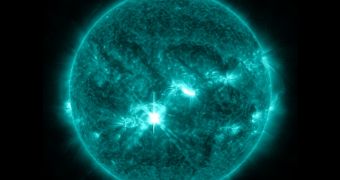The sun has been strangely quiet lately. This year, and this period in particular, was supposed to be the most agitated, the height of the sun's 11-year activity cycle. But scientists were quite surprised that the flipping of the magnetic poles this year hasn't resulted in too much chaos on the surface of the star.
That's good for us, it means there aren't too many solar flares to interfere with communications or fry power grids.
But that's not to say that the sun is completely quiet, there's still some activity and things may be picking up in the coming weeks, these kinds of things are hard to predict.
NASA's Solar Dynamics Observatory has recently captured a rather sizable M-class flare. M-class flares are the smallest that can cause some interference on Earth, like interrupting radio signals at the poles.
"This flare is classified as an M9.4 flare, on a scale from M1 to M9.9. This rating puts it at the very top of the scale for M class flares," NASA explains. The flare erupted today at 00:30 UTC. Its effects will be felt on Earth a few days from now.

 14 DAY TRIAL //
14 DAY TRIAL //